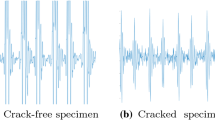Abstract
The analysis of a number of publications proved that artificial neural networks show much promise in identification of signals and images in nondestructive testing. A three-layered neural network with backward propagation has been used in separating noisy signals due to flaws from spurious signals (due to a slant or separation of an eddy-current transducer) in the process of eddy-current testing. Network characteristics at different numbers of neurons in its layers have been investigated. Probabilities of signal identification at different rms noise intensities have been determined.
Similar content being viewed by others
REFERENCES
Kawada Akira and Hayash Sigeyu, Methods for Diagnostic of Works Using Computer-Simulated Neural Networks, Gien, 1994, no. 80, pp. 16-20.
Roy Amitava, Barat, P., and De Swapan Kumar, Material Classification through Neural Network, Ultrasonics, 1995, no. 33, pp. 175-180.
Wang Suju, Use of Neural Networks in Nondestructive Tests with the Help of Eddy Currents, Narjing HongKong Daxue Huebao (J. Narjing Univ. Aerocom. and Astronaut.), 1995, vol. 27, no. 5, pp. 696-700.
Lei Yinishao and Ma Xinshen, Use of Intelligent Neural Networks in Eddy-Current Tests, Wasan Jinance (Nondestructive Testing), 1994, vol. 16, no. 2, pp. 31-33.
Kreis Thomas, Juptner Werner, and Biedermann Ralf, Neural Network Approach to Holographic Nondestructive Testing, Appl. Optics, 1995, vol. 34, no. 8, pp. 1407-1415.
Koh Chan Scop, Mohammed Osana A., and Hahn Song-yop, Detection of Magnetic Materials Using Artificial Neural Network with Modified Simulated Annealing, IEEE Trans. Magn., 1994, vol. 30, no. 5, pt. 2, pp. 3644-3647.
Wetzlar Dietmar, Neural Networks in Measuring Techniques, Techn. Mess., 1995, vol. 62, no. 3, pp. 87-90.
Cai Yu-dong and Vao Lin-Chang, Utilization of Artificial Neural Network in Calibration of Transducers, Chin. I.: Sci. Instrum., 1994, vol. 15, no. 3, pp. 299-302.
Pham, D.T. and Bayro-Corrochano, E.I., Neural Classifiers for Automated Inspection, Inst. Mech. Eng., 1994, vol. 208, no. 2, pp. 83-89.
Enokizino, M., Todaka, T., Akita, M., and Nagata, S., Rotational Magnetic Flux Sensor with Neural Network for Nondestructuve Testing, IEEE Trans. Magn., 1993, vol. 29, no. 6, pt. 1, pp. 3195-3197.
Notaka Masayoshi, Yabe Yasuhiro, Takadoya Masaki, and Egoshira Niwa, Application of Mathematical Methods and Neural Networks to Nondestructive Testing, Mitsubishi Sogo Kenkyujo shoho (J. Mitsubishi Research Institute), 1995, no. 23, pp. 182-197.
Nogami Takeki, Yokoi Yoshihide, Kasai Masao, Kawai Katsurori, and Takaura Katsuhisa, Failure Diagnostic System for Air-Operated Control Valuese Using Neural Network, ISME Int. I.C., 1995, vol. 38, no. 4, pp. 693-632.
Takumo Masanori, Shinke Noboru, and Motono Hitochi, Evaluation of Function of Spot-Welded Joint Using Ultrasonic Inspection. Nondestructive Evaluation of Tension Shearing Strength with Neural Network, ISME Int. I.A., 1996, vol. 39, no. 4, pp. 626-632.
Donka, C., Ultrasonic Testing of Materials with Neural Network, Strojn. Vestn., 1996, vol. 42, no. 1, pp. 17-26.
Huang Minchao and Chen Qizhi, Control of Transducers Using Fuzzy Sets, Trainable Artificial Neural Networks for Detection and Localization of Flaws in Rocket Engines, Guofang Keji Daxue Xuebao (J. National Univ. Defense Technol.), 1996, vol. 18, no. 4, pp. 7-10.
Oxara, D., High-Accuracy Automatic Inspection System Based on Neural Network, Techno Jap., 1995, vol. 28, no. 2, pp. 100-105.
Shi Keren and He Zhaohui, Use of Artificial Neural Networks for Processing Signals in Eddy-Current Tests, Nondestructive Testing, 1996, vol. 18, no. 7, pp. 100-201.
Takuma Masanori, Shinke Noboru, and Motono Hitoshi, Nondestructive Testing of Welded Joints Using Neural Networks, Nihon Kikai Gakkai Ronbunshu (Trans. Jap. Soc. Mech. Eng.), 1996, vol. 62, no. 595, pp. 776-780.
Liu Weijun, Wang Xiaoming, Wu Hongji, and Liu Jian, Nondestructive Testing of Welded Joints by Ultrasonic Methods Using Neural Networks, Dalian Ligong Daxue Xuebao (J. Dalian Univ. Technol.), 1998, vol. 38, no. 5, pp. 548-552.
Rajeic Vlatka, Neural Network for Wood Member Classification Based on the Results from Nondestructive Testing of Wood Samples, Proc. 4th Int. Conf. Sloven. Soc. Nondestructive Test., Appl. Contemp. Nondestructive Test. Eng., Ljubljana, April 24–25, 1997, pp. 59-66.
Tain Hoisheng, Li Yanning, Cao Xiuyuo, and Li Ye, Testing of Concrete Quality Based on Novel Neural Network with Fuzzy Logic, Xian Jiaotong Daxue Xuebao (J. Xian Jiaotong Univ.), 1997, vol. 31, no. 1, pp. 25-31.
Guo, G. and Yi, W., Identification of Structural Boundary Conditions and Analysis of Flaws Based on the Use of Neural Networks, Nunan Daxue Xuebao. Zuran Kehue Ban (J. Hunan Univ. Natur. Sci.), 1998, vol. 25, no. 1, pp. 71-76.
Tao Chen, Shaomu Han, Shubong Huong, and Dechaug Li, Use of Hybrid Neural Networks in Diagnostic of Turbine Generators, Huashong Ligong Daxue Xuebao (J. Huashing Univ. Sci. and Technol.), 1998, vol. 26, no. 6, pp. 37-39.
Wassermann, F., Neurocomputer Techniques. Theory and Practice. Translated under the title Neirokomp'yuternaya tekhnika. Teoriya i praktika), Moscow: Mir, 1992.
Werbos, P.I., Beyong Regression: New Tools for Prediction and Analysis in the Behavioral Sciences, Masters Thesis, Harward University, 1974.
Parkar, D.B., Learning Logic. Invention Report, S. 81-64, File 1, Office of Technology Licensing, Standford University, Standford, CA, 1982.
Rumelhart, D.E., Hinton, G.E., and Williams, R.I., Learning Internal Representations by Error Propagation, Parallel Distributed Processing, 1986, vol. 1, pp. 318-362, Cambridge MA: MIT Press.
Pribory dlya nerazrushayushchego kontrolya materialov i izdelii (Instruments for Nondestructive Testing of Materials and Works), Klyuev, V.V., Ed., Moscow: Mashinostroenie, 1976.
Beda, P.I., Investigation of Signals from Applied Transducer versus Dimensions and Locations of Crack-Like Flaws, Defektoskopiya, 1970, no. 1, pp. 62-67.
Author information
Authors and Affiliations
Rights and permissions
About this article
Cite this article
Khandetskii, V.S., Antonyuk, I.N. Use of Artificial Neural Networks in Identification of Modulated Pulses Due to Flaws. Russian Journal of Nondestructive Testing 37, 278–285 (2001). https://doi.org/10.1023/A:1012359106804
Issue Date:
DOI: https://doi.org/10.1023/A:1012359106804




